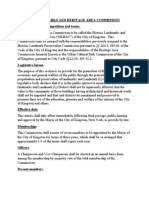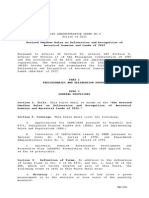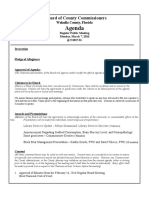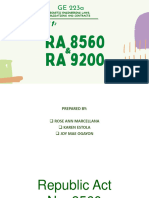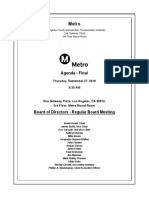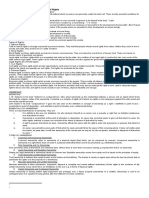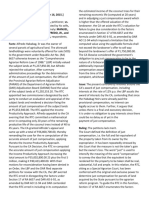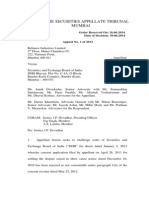H-1 Ordinance Revision
H-1 Ordinance Revision
Uploaded by
gscplanningCopyright:
Available Formats
H-1 Ordinance Revision
H-1 Ordinance Revision
Uploaded by
gscplanningOriginal Description:
Copyright
Available Formats
Share this document
Did you find this document useful?
Is this content inappropriate?
Copyright:
Available Formats
H-1 Ordinance Revision
H-1 Ordinance Revision
Uploaded by
gscplanningCopyright:
Available Formats
ORDINANCE NO.
2013-__
AN ORDINANCE AMENDING ARTICLE IV, SECTION 4.7 OF THE
GEORGETOWN-SCOTT COUNTY ZONING
WHEREAS, the Georgetown/Scott County Planning Commission, after
proper notice, held a public hearing on May 10
th
and J une 14
th
, 2012; and recommended
to the Georgetown City Council the following text amendment to Section 4.7 of the
Georgetown/Scott County Zoning Ordinance;
NOW THEREFORE, BE IT ORDAINED BY THE CITY COUNCIL OF THE CITY OF
GEORGETOWN:
SECTION ONE
Section 4.7 of the Georgetown Scott County Zoning Ordinance is deleted and the
following substituted in lieu thereof:
ARTICLE 4.7 HISTORIC DISTRICT
Section 1 : PURPOSE AND INTENT
The provisions of this Article are established to maintain and preserve the unique historic
and architectural characteristics of areas and buildings in the cities of Georgetown,
Stamping Ground and Sadieville and the unincorporated areas of Scott County,
Kentucky which have special or distinctive features or a special historic, architectural,
aesthetic or cultural interest and value to the city, county, state and nation. This Article is
also intended to promote the use of these areas and buildings, strengthening the
economy of the County and its Cities and enhancing its attractions to residents, visitors
and tourists. This Article shall promote the educational, cultural and general welfare of
the people; stabilize and improve property values in historic districts and in the Cities
and County as a whole; and foster civic pride in the value of notable accomplishments of
the past, enhancing the visual and aesthetic character, diversity and interest of Scott
County.
The provisions of this Article are established due to the following findings: (a) areas and
buildings having historic and architectural value have been neglected, altered or
destroyed notwithstanding the feasibility and desirability of preserving and continuing the
use of such areas and buildings and without adequate consideration of the irreplaceable
loss to the people; (b) historic areas and buildings may be preserved and improved
through appropriate changes; (c) this article will benefit all the residents and all the
owners of property in Georgetown, Stamping Ground, Sadieville and Scott County; and
(d) the Federal and Commonwealth of Kentucky governments have passed laws to
protect and preserve historic districts and landmarks including the 1989 amendments to
the National Historic Preservation Act which established a Certified Local Government
program thus creating a federal-state-local partnership to encourage preservation efforts
by cities and counties.
It is declared as a matter of public policy that the preservation and use of historic
districts and landmarks is for the public good and is desired in the interest of the
prosperity, welfare and economic well-being of the people.
Section 2: DEFINITIONS:
Alteration: Work that changes the appearance of the exterior of a landmark or a building
or structure in a historic district or on a landmark site regardless of whether the work
requires a building permit from the government.
Certificate of Appropriateness: The permit, issued by the Preservation Board, which
gives its approval for work to be done in the Historic (H-1) Overlay District or on a
landmark or landmark site.
Certified Local Government: A government meeting the requirements of the National
Historic Preservation Act and the implementing regulations of the U.S. Department of the
Interior and the Kentucky Heritage Council.
Demolition: Any act that destroys in whole or in part a landmark or a building or
structure in a historic district or on a landmark site.
Historic District: An area meeting one or more of the criteria contained in Section 10E of
this Ordinance.
Landmark: A building or structure meeting one or more of the criteria contained
in Section 10E of this Ordinance.
Landmark Site: Th
e land on which a landmark and related buildings and structures are located and the
land that provides the grounds, the premises or the setting for a landmark.
Ordinary Repair and Maintenance: Any work, the purpose of which is to correct
deterioration or prevent deterioration of a designated historic property. The work shall
restore the property to its appearance prior to deterioration or shall result in the
protection of its present appearance. The work shall involve the use of the same building
materials or available materials that are as close as possible to the original. Work that
changes the external appearance of a property shall be considered an alteration for the
purposes of this Ordinance.
Preservation Board: The Georgetown-Scott County Historic Property Review Board.
Section 3: APPLICATION OF HISTORIC PRESERVATION AREA:
Within all of the zoning districts shown on the Georgetown-Scott County zoning map,
whether classifications now existing or to be created subsequent to the adoption of this
Ordinance, there is established an (H-1) overlay Historic Preservation Area classification
and regulations. The Historic Preservation Area and the landmark and landmark site
classification and regulations, provided below, shall be in addition to the zoning
classification and regulations in effect on the date of the Historic Preservation Area or
landmark and landmark site designation, or as such zoning classifications as may be
amended thereafter.
Whenever conflicts shall arise between the provision contained in this Ordinance, and
the underlying zoning classification and regulations, it is intended that the provision set
forth relating to the Historic Preservation Area and the landmark and landmark site shall
take precedence.
Section 4: CREATION OF A BOARD:
A historic preservation board is created according to and in conformance with KRS
167.083 (3)(y), KRS 82.026, KRS 82.660 and KRS 100.203. This board shall be known
as the Georgetown/Scott County Historic Property Review Board or simply Preservation
Board.
Section 4A: Board Membership:
The Historic Property Review Board shall consist of five citizen members. The members
shall all have a demonstrated interest in historic preservation. At least two members
shall be property owners within an existing H-1 District. At least two members shall have
training or experience in a preservation-related profession, architecture, history,
archeology, architectural history, planning or related fields. When one or two
professional members are not available, the appointing authority may appoint other
persons interested in historic preservation to serve. When the Preservation Board
reviews an issue that would more appropriately be evaluated by a professional member,
the field of whom is not represented on the Preservation Board, the Board shall seek
expert advice before rendering its decision.
Members of the Historic Property Review Board shall serve without compensation. They
may be reimbursed, however, for expenses incurred in the performance of their duties in
accordance with rules to be adopted by the Preservation Board. All members shall
attend at least one educational meeting per year approved by the Kentucky State
Historic Preservation Office. The Preservation Board appointments shall be made in the
following way. Two members shall be appointed by the Mayor of the City of Georgetown
subject to approval of the City Council and two members shall be appointed by the
J udge Executive of Scott County subject to approval of the Scott County Magistrates.
The fifth member shall be appointed by the Georgetown-Scott County Planning
Commission. The Mayor of the City of Georgetown shall make the first appointment with
the appointments alternating between the J udge Executive of Scott County and the
Mayor of the City of Georgetown, with the Georgetown-Scott County Planning
Commission having the last appointment. The appointing authorities shall make every
attempt to seat a member who is a resident of an H-1 Historic District or landmark
building.
Section 4B: Term of Office and Vacancies:
The term of office of the members shall be three (3) years ending on J une 30 of the
designated year. The term of office of Preservation Board members first appointed shall
be staggered so that two (2) members serve two (2) years and two (2) members serve
one (1) year and one member serves three (3) years. The term of all later appointments
shall continue the staggered pattern by a having a term of three years. Any member
shall be limited to three (3) terms of service. Each member shall serve until the
appointment and qualification of his successor. When a vacancy occurs during the term
of office of a member of the Board, it shall be filled within sixty (60) days. When a
vacancy occurs other than through expiration of the term of office, it shall be filled for the
remainder of that term.
Section 4C: Board Officers:
The Preservation Board annually shall elect a Chairman and Vice Chairman and any
other officers it deems necessary. Any officer shall be eligible for re-election at the
expiration of his term. A member of the Board or its designee shall prepare the minutes
of the Board meetings which shall be available for public inspection in the Georgetown-
Scott County Planning Commission office.
Section 4D: Conflict of Interest:
Any member of the Preservation Board who has a direct or indirect financial interest in
the outcome of any question before the body shall disclose the nature of the interest and
disqualify himself from voting on the question. He shall not be counted for the purpose of
a quorum. Any conflict arising between the application of this provision and the City of
Georgetown Ethics Ordinance, shall be resolved in favor of the Ethics Ordinance.
Section 4E: Oath of Office
All members of the Preservation Board shall, before entering upon their duties, by taking
the oath of office prescribed by Section 228 of the Constitution of the Commonwealth of
Kentucky before any judge, county judge/executive, notary public, clerk of a court or
justice of the peace within the district or county in which he resides.
Section 4F: Removal from Office:
Any member of a Preservation Board may be removed by the appointing authority for
inefficiency, neglect of duty, malfeasance, or conflict of interest. In the event the
appointing authority exercises the power to remove a member of the Preservation
Board, he/she shall submit a written statement to the City Council, Scott County Fiscal
Court or the Planning Commission setting forth the reason for removal. The statement
shall be read at the next meeting of the Preservation Board, which shall be open to the
general public. The member so removed shall have the right of appeal of the removal to
the Scott County Circuit Court.
Section 5: POWERS AND DUTIES OF THE GEORGETOWN/SCOTT COUNTY
HISTORIC PROPERTY REVIEW BOARD:
In addition to the powers and duties stated elsewhere, the Preservation Board shall
take action necessary and appropriate to accomplish the purpose of this article. These
actions may include, but are not limited to: conducting a survey of historic buildings and
areas, drafting a historic preservation element for use in the preparation of the
community Comprehensive Plan, recommending the designation of historic districts
and individual landmarks, regulating changes to designated property including
proposed alterations that are visible to the public from a street, regulating demolition,
relocation and new construction as provided below, recommending guidelines for
changes to designated property, working with and advising the federal, state and
county governments and advising and assisting property owners and other persons and
groups including neighborhood organizations who are interested in historic preservation
to promote or further preservation education throughout the community. The
Preservation Board shall have the power to charge fees on applications for Certificates
of Appropriateness submitted to the Preservation Board.
Section 6: MISCELLANEOUS ACTIVITIES:
In the development of the Certified Local Government program, the Local
Government may ask the Preservation Board to perform other responsibilities that
may be delegated to the Government under the National Historic Preservation Act.
Section 7: SURVEY OF HISTORIC BUILDINGS AND AREAS:
In making a survey of buildings and areas, the Preservation Board shall conduct the
work in accordance with the guidelines established by the State Historic Preservation
Office. The Board shall maintain its survey of historic buildings and areas as an ongoing
project. The Board shall use the historic preservation element it drafts to assist the
Planning Commission in its overall planning efforts and in carrying out the
Comprehensive Plan.
Section 8: ORGANIZATION:
Section 8A: Bylaws:
The Board shall adopt and publish bylaws for the transaction of its business. The Board
shall hold monthly public meetings and special public meetings, when necessary. All
meetings shall be advertised, as required by KRS Chapter 424, have a previously
available agenda and comply with the Kentucky Open Meeting Statute, 61.895. A simple
majority of the total membership of the Board shall constitute a quorum. A simple
majority of the quorum shall be required for decisions involving historic buildings and
areas. Decisions shall be made at a public meeting with applicants notified of meetings
and advised of decisions.
Section 8B: Minutes and Records:
The Board shall keep minutes and records of all proceedings including regulations,
standards of review, transactions, findings and determinations, the number of votes for
and against each question and the absence or abstention voting of any member. The
Board shall also prepare and keep on file, available for public inspection, a written
annual report of its activities, cases, decisions, qualifications of members and other
work.
Section 8C: Staff:
The Board may retain the services of an employee who shall have professional
qualifications in historic preservation or a closely related field or contract with a
private organization for the services of a person with the same qualifications to
assist the Board.
Section 8D: Board Funds:
The Board, in addition to any appropriations made by the City of Georgetown, City of
Sadieville, City of Stamping Ground or the Scott County government, shall have the right
to receive, hold and spend funds which it may receive from any source, both in and out
of the Commonwealth of Kentucky, for the purpose of the provisions of this article.
Section 9: ADMINISTRATION OF OATHS:
The Chair of the Preservation Board, or the Chair of a meeting from which the Board
Chair is absent, shall have the power to administer an oath to witnesses prior to their
testifying before the Board on any issue.
Section 10: NOMINATIONS TO THE NATIONAL REGISTER OF HISTORIC
PLACES:
Section 10A: Solicitation of Nominations:
The Board shall solicit nominations for the National Register of Historic Places from
the Cities of Georgetown, Stamping Ground, Sadieville, Scott County and private
individuals.
Section 10B: Public Hearing and Nomination submission:
The Board shall review each nomination at a public hearing. Such hearing shall be
advertised as required by KRS Chapter 424. The Board will submit their
recommendation on each nomination, including those comments generated from the
Public Hearing to the Office of the City Clerk for each municipality or to the County
Clerk for areas in the County.
Section 10C: Nomination Timetable and Appeal Right:
Within sixty (60) days of the receipt of a nomination from a private individual or the
initiation of a nomination by a local jurisdiction, the local jurisdiction shall inform the State
Historic Preservation Office and the owner of the property of the local jurisdictions and
Preservation Board recommendation regarding the eligibility of the property. If both the
Preservation Board and the local jurisdiction recommend that a property not be
nominated, the State Historic Preservation Office will so inform the property owner and
the state review board.
Section 11: DESIGNATION OF LANDMARKS AND LANDMARK SITES AND
HISTORIC DISTRICTS
Section 11A: Administrative Process:
The Preservation Board shall recommend to the Georgetown/Scott County Planning
Commission the designation of individual landmarks, landmark sites and historic
districts. A public hearing shall be held and a recommendation made by the Planning
Commission. The City Council for any municipality or the County Fiscal Court for any
area outside the municipalities shall make these designations by the enactment of an
ordinance. Consideration of the designation of a landmark, landmark site or a district
may originate from the Cities of Georgetown, Stamping Ground, Sadieville, or the Scott
County Fiscal Court, the Preservation Board, or a private individual. A person or an
organization proposing a designation shall give the Preservation Board the names and
addresses of the owners of the affected property and the owners of all adjoining property
as listed on the tax rolls of the Scott County Property Valuation Administrator.
Section 11B: Preliminary Information:
The Preservation Board shall assemble information about the property or district being
considered for designation prior to conducting a public hearing and after publication of
notice as required by KRS Chapter 424 on the proposed designation. When a hearing
before the Planning Commission is scheduled on a proposal designating individual
Landmarks or Landmark Sites, the following notice shall be given in addition to any other
notice required by statute, local regulation or ordinance.
Section 11C: Notice:
(1) Notice of the hearing shall be posted conspicuously on the property for which the
designation is proposed for fourteen (14) consecutive days immediately prior to the
hearing.
(2) The hearing sign shall be constructed of durable material, shall be written in letters
sufficiently large to be read from the public street and shall state the telephone number
of the Preservation Board, along with the time, place and date of hearing.
(3) Notice of the hearing shall be given at least fourteen (14) days in advance of the
hearing by first-class mail, to an owner of every parcel of property adjoining the property
for which the designation is proposed. It shall be the duty of the person or persons
proposing the designation to furnish to the Preservation Board the names and addresses
of the owners of all affected and adjoining property. Records maintained by PVA may be
relied upon to determine the identity and address of owners.
Section 11 D: Adoption and Publication of Guidelines:
At least thirty (30) days before its first public hearing on a designation, the Preservation
Board shall publish general guidelines that will apply to local (H-1) landmarks and
historic districts. The Board will assist owners in the preservation and rehabilitation of
their property. The guidelines shall be submitted to the Fiscal Court or City Council with
jurisdiction over the local (H-1) district for its approval. The general guidelines shall
include the Secretary of the Interior's Standards and Guidelines for the Treatment of
Historic Properties and other guidelines that will apply to all designated property in the
H-1 District. No later than thirty (30) days before any public hearing, the subject of which
is the designation of a historic building, the Preservation Board may adopt and publish
additional guidelines that will supplement the general guidelines. They shall not limit new
construction to any one architectural style but shall seek to preserve the character and
integrity of the landmark or the historic district. The guidelines shall suggest changes
that would be appropriate for landmarks or for property in historic districts. After a
designation the Historic Property Review Board may expand or amend the guidelines it
has adopted, provided it holds a public hearing on the changes and submits the
proposed changes to the Legislative Bodies of Scott County and the Cities of
Georgetown, Stamping Ground, Sadieville for their approval.
Section 11E: Criteria for Designation as a Landmark or Historic District
A landmark or historic district shall qualify for designation when it meets one or more of
the following which shall be discussed in a Preservation Board report making its
recommendations to the City Council or Fiscal Court.
(1) Its value as a reminder of the cultural or archeological heritage of the city, county,
state or nation;
(2) Its location as a site of a significant local, state or national event;
(3) Its identification with a person or persons who significantly contributed to the
development of the city, county, state or nation;
(4) Its identification as the work of a master builder, designer or architect whose
individual work has influenced the development of the city, county, state or nation;
(5) Its value as a building that is recognized for the quality of its architecture and its
retention of sufficient elements showing its architectural significance;
(6) Its character as a geographically definable area possessing a significant
concentration of sites, buildings or structures united by past events or aesthetically by
plan or physical development; or
(7) Its character as an established and geographically definable neighborhood, united by
culture, architectural style or physical plan and development.
Section 11F: Board Recommendation:
After evaluating the testimony at its public hearing, survey information and other
material it has assembled, the Preservation Board shall make its written
recommendation to the Planning Commission. The recommendation for landmark
designation shall include a recommendation for the designation of a landmark site.
Section 11G: Planning Commission Public Hearing:
Upon receipt of the written report, the Planning Commission shall hold a public hearing
in accordance with the requirements of a zoning map amendment as contained in KRS
Chapter 100.212. Based upon the record of the public hearing and the Comprehensive
Plan, the Planning Commission shall forward its written recommendation on the Zoning
Map amendment to the local legislative body. If the local legislative body approves the
proposed designation, it shall amend the Official Zoning map to include the proposed
historic overlay designation.
Section 11H: Council Action on Planning Commission Recommendation:
The City Council or County Fiscal Court shall approve, modify or disapprove the
proposed designation within sixty (60) days after receiving the recommendations and
records of the Preservation Board and Planning Commission. If the City Council or
Fiscal Court decide to make a designation without the recommendation of the
Preservation Board and Planning Commission, or if it has modified the recommended
designation, the City Council or Fiscal Court shall request the Preservation Board and
the Planning Commission to either consider the designation in accordance with Section
11E or to reconsider its earlier decisions.
Section 11I: Notification of Board Decision:
The Preservation Board shall notify the owner of each affected property of the City
Council's or Fiscal Courts decision. The Board shall record the designation of a
property as a landmark or as a part of a historic district in the records of the Scott
County Clerk's office. The Board shall also give notice of the decision to the
government offices in the City and County which shall retain it for reference.
Section 11J : Amendment or Rescission of Designation:
The amendment or rescission of any designation shall be accomplished through the
same procedure as the original designation.
Section 12: APPROVAL OF CHANGES TO LANDMARKS, LANDMARK SITES AND
PROPERTY IN HISTORIC DISTRICTS
Section 12A: Certificate of Appropriateness
No person shall undertake the following actions affecting a local (H-1) landmark,
landmark site or a property in a local (H-1) historic district until such person has
completed the Certificate of Appropriateness application process before the Preservation
Board:
(1) Alteration of the exterior part of the building or structure that is visible to the public.
(2) New construction.
(3) Demolition, or
(4) Relocation.
Section 12B: Building Permit Procedure
The Building Inspector shall forward to the Preservation Board every application
requesting a permit for work to the exterior of a landmark building, site or a building in a
local (H-1) district. The Building Inspector shall give the applicant a form from the Board
requesting necessary information from the applicant. The applicant shall provide, where
applicable, drawings of the proposed work, photographs of the existing building or
structure or site and adjacent properties. The applicant shall provide information about
the building materials to be used. In the event work is being performed prior to the
completion of the required Certificate of Appropriateness process, the Board shall direct
that a Stop Work Order be issued by the City Building Inspector. The City may apply in
Circuit Court for an injunction to enforce its Stop Work Order. The disregard of a Stop
Work Order by a person performing work otherwise requiring satisfaction of this
Ordinance, shall constitute a violation of this Ordinance, subjecting the person to the
penalties set out below.
Section 12C: Exterior Alterations covered this Ordinance Not Requiring Building
Permit:
When a person wishes to undertake an exterior alteration visible to the public affecting a
landmark, a landmark site or a property in a historic district that does not require a
building permit, that person shall apply directly to the Preservation Board for Certificate
of Appropriateness review. In the event work requiring review under this provision, but
not a Building Permit, is being performed without compliance with this section, the Board
shall direct that a Stop Work Order be issued. The City may apply in Circuit Court for an
injunction to enforce its Stop Work Order. The disregard of a Stop Work Order by a
person performing work otherwise requiring satisfaction of this Ordinance, shall
constitute a violation of this Ordinance, subjecting the person to the penalties set out
below.
Section 12D: Procedure for Applications for Demolition:
When an applicant wishes to demolish a landmark, a building or structure on a
landmark site, or a building or structure in a local (H-1) historic district, the
Preservation Board shall negotiate with the applicant to see if an alternative to
demolition can be found. The Board may ask interested individuals and organizations
for assistance in seeking an alternative to demolition and in obtaining estimates on
rehabilitation costs for the threatened building.
After its public hearing, the Preservation Board may decide that a building or
structure in a historic district or on a landmark site may be demolished because it
does not contribute to the historic district or to the landmark. In demolition
applications, the Preservation Board shall study the question of economic hardship
for the applicant and shall determine whether the landmark or the property in the
historic district can be put to reasonable beneficial use without the approval of the
demolition application. In the case of an income producing building, the Preservation
Board shall also determine whether the applicant can obtain a reasonable return
from his existing building. The Board may ask applicants for additional information to
be used in making these determinations. These determinations shall be in addition
to the points contained in Section 12G. If economic hardship or the lack of
reasonable return is not proved, the Board shall deny the demolition, unless it finds
grounds to grant the demolition application under the points contained in Section
12G
Section 12E. Relocation:
When the applicant wishes to move a landmark, a building or structure on a
landmark site, or a building or structure in a local (H-1) historic district or wishes to
move a building or structure to a landmark site or to a property in a local (H-1)
historic district, the Board shall consider: (1) The contributions the building or
structure makes to its present setting; (2) whether there are definite plans for the
site to be vacated; (3) whether the building or structure can be moved without
significant damage to its physical integrity; and (4) the compatibility of the building or
structure to its proposed sites and adjacent properties. These considerations shall
be in addition to the points contained in Section 12G.
Section 12F: Public Hearing on Certificate of Appropriateness Application; Time For
Action; and Findings Required:
The Preservation Board shall hold a public hearing on each Certificate of
Appropriateness application at its next scheduled monthly meeting provided the
completed application is received at least seven (7) days prior to that meeting. A
decision shall be rendered at that meeting, unless the Board deems the application
incomplete. In the event the Board requests additional necessary information, the matter
shall be scheduled for decision at the Board's next regular scheduled monthly meeting.
For good cause, the Preservation Board may extend the time for decision up to an
additional three (3) months when the application is for demolition, new construction or
relocation. The Board shall state the specific reasons for any extraordinary delay in
decision making.
The Preservation Board shall approve or disapprove each application. It shall state the
reasons, in writing, for its decision citing the criteria contained in the applicable sections
of this Ordinance and its guidelines. The Board may suggest modifications to an
application. It may approve a Certificate of Appropriateness providing for revisions in the
plans submitted. The Building Inspection Department shall be notified in writing of any
action taken by the Historic Property Review Board to coordinate the issuance of
building permits, if applicable.
Section 12G: Criteria for Board Consideration:
In making a decision on an application, the Board shall use the Georgetown/Scott
County Historic District Design Guidelines and the Secretary of Interiors Standards and
Guidelines for the Treatment of Historic Properties, as well as other current sources that
outline appropriate building treatment options, including but limited to, the National Park
Services Preservation Briefs. The Board shall also consider: (1) The effect of the
proposed work on the landmark or the property upon which such work is to be done; and
(2) the relationship between such work and other structures on the landmark site or
other property in the historic district. In evaluating the effect and the relationship, the
Board shall consider historical and architectural significance, architectural style, design,
arrangement, texture and materials. The Certificate from the Board shall not relieve the
property owner from complying with the requirements of other state and local laws and
regulations.
Section 12H: Consideration of the Applicant's Needs:
In making a decision on an application, the Preservation Board shall be aware of the
importance of finding a way to meet the current needs of the applicant. The Board shall
also recognize the importance of approving plans that will be reasonable for the
applicant to carry out. Before an applicant prepares his plans, he is encouraged to bring
a tentative proposal to the Board for its comments.
Section 12I: Appeal:
Following a denial of an application there shall be a 30-day negotiating period during
which period no appeal may be taken. During this time the applicant and Preservation
Board shall negotiate to find an alternative which would comply with the Preservation
Board guidelines.
After this period the applicant must first appeal to the Georgetown-Scott County
Planning Commission. The appeal must be filed within 30 days after the expiration of the
30-day negotiation period. The Planning Commission shall render a decision within 60
days. If the decision is adverse to the applicant, the applicant may appeal to the Circuit
Court.
The appeal to the Circuit Court shall be taken within 30 days of final action by the
Planning Commission.
Section 13: CONFORMITY WITH CERTIFICATE OF APPROPRIATENESS
Section 13A: Compliance with Certificate of Appropriateness for new Construction,
Demolition and Relocation:
All work performed pursuant to a Certificate of Appropriateness related to new
construction, demolition, or relocation shall conform to the provisions of such Certificate.
It shall be the responsibility of the Board to inspect from time to time any work being
performed to assure such compliance. In the event work is being performed which is not
in accordance with such Certificate, a Stop Work Order shall be issued, and all work
shall cease on the designated property. No additional work shall be undertaken as long
as such Stop Work Order shall continue in effect. The City or County may apply in
Circuit Court for an injunction to enforce its Stop Work Order. The disregard of a Stop
Work Order by a person performing work otherwise requiring satisfaction of this
Ordinance, shall constitute a violation of this Ordinance, subjecting the person to the
penalties set out below.
Section 13B: Compliance with Certificate of Appropriateness for Alteration of the
Exterior Part of the Building or Structure that is Visible to the Public:
All work performed pursuant to a Certificate of Appropriateness related to the alteration
of the exterior part of the building or structure that is visible to the public shall conform
to the provisions of such Certificate. It shall be the responsibility of the Board to
educate and encourage the applicant to utilize the terms and conditions of the
Certificate in order to promote the preservation and use of historic properties and
landmarks.
To this end, it shall be the responsibility of the Board to inspect from time to time any
work being performed to assist the applicant and to assure such compliance as the
applicant can achieve. In the event work is being performed which is not in accordance
with such Certificate, a Stop Work Order shall be issued. The Board shall issue a
written notice of deficiencies which outlines deviations from the Certificate.
An applicant's compliance with the terms of a Certificate of Appropriateness related to
the alteration of the exterior part of the building or structure that is visible to the public is
mandatory. A person performing work in contradiction to the terms of the Certificate is in
violation of this Ordinance.
Section 14: MAINTENANCE REPAIRS
Section 14A: Ordinary Repairs and Maintenance:
Ordinary repairs and maintenance may be undertaken in accordance with local building
regulations without a Certificate of Appropriateness provided any work on a landmark, a
landmark site or a property in a local (H-1) historic district does not change its exterior
appearance that is visible to the public. Ordinary repairs and maintenance shall include,
but not be limited to, repair work done with the same materials and historical techniques
and the replacement of windows and doors with identical materials or items.
Section 14B: Dangerous Conditions:
In any case where the Building Inspector determines that there are emergency
conditions dangerous to life, health or property affecting a landmark, a landmark site or
a property in a historic district, he may order the remedying of these conditions without
the approval of the Historic Property Review Board. The Building Inspector shall
promptly notify the Chairman of the Board of the action being taken.
Section 14C: Duty to Keep in Good Repair:
Every person in charge of a landmark, a landmark site or a property in a local (H-1)
historic district shall, in accordance with local building codes and property maintenance
regulations, keep in good repair: 1) all of the exterior portions of such buildings or
structures; and (2) all interior portions which, if not so maintained, may cause such
buildings or structures to deteriorate or to become damaged or otherwise to fall into
disrepair. The purpose of this section is to prevent a person from forcing the demolition
of his building by neglecting it and permitting damage to the building by weather or
vandalism. No provision in this article shall be interpreted to require an owner or tenant
to undertake an alteration or to restore his building to its original appearance or to
repair his building when it has been damaged by fire or an act of nature and
rehabilitation is not economically feasible. The failure to keep a property otherwise
subject to this Ordinance shall constitute a violation of this Ordinance, subjecting the
person to the penalties set out below.
Section 14D: Board's Role in Securing Properties in Disrepair:
The Preservation Board shall request a meeting with a property owner or tenant when
his landmark or his building in a local (H-1) historic district is in poor repair, and the
Board shall discuss with the owner ways to improve the condition of his property. After
this step the Board may request the Building Inspector to take action under City or
County regulations to require correction of defects in any building or structure
designated under this article so that such building or structure shall be preserved in
accordance with the purposes of this article. The action taken may include boarding up
the doors, windows and other parts of the building and additional steps to stabilize
walls, roofs, and other parts of the building.
Section 14E: Conformance with Kentucky Building and Property Maintenance Codes
The provisions of this Section 13 shall be in addition to all other provisions of the
Kentucky Building Code or Property Maintenance Code requiring buildings and
structures to be kept in good repair.
Section 15: PENALTIES
Fines and penalties may be imposed upon persons and/or property owners where work
is performed in violation of this ordinance according to provisions of KRS, Section
100.991
SECTION TWO
If any section, subsection, sentence, clause or phrase of this ordinance is held
unconstitutional or otherwise invalid, such infirmity shall not affect the validity of the
remaining portions of this ordinance.
SECTION THREE
All other ordinances and parts of ordinances in conflict with this ordinance are hereby
repealed to the extent of the conflict.
SECTION FOUR
This Ordinance shall take effect upon passage and publication according to law.
PUBLICLY INTRODUCES AND READ FIRST TIME:
PUBLICLY READ SECOND TIME AND PASSED:
APPROVED:
_________________________________________________
Everette L. Varney, Mayor
ATTEST:
_________________________________________________
Tracie Hoffman, City Clerk
You might also like
- Offer LetterDocument2 pagesOffer LetterAnonymous 6cQ2N2c5B100% (2)
- Metro Board of Directors Dec. 2018 MeetingDocument21 pagesMetro Board of Directors Dec. 2018 MeetingMetro Los AngelesNo ratings yet
- Augusta Historic Preservation Commission OrdinanceDocument26 pagesAugusta Historic Preservation Commission OrdinanceSusan McCordNo ratings yet
- Polish Historic District AmendmentsDocument10 pagesPolish Historic District Amendmentsrlisi269No ratings yet
- L R HLPC Heritage Leislation PDFDocument23 pagesL R HLPC Heritage Leislation PDFDaily FreemanNo ratings yet
- Agenda: Board of County CommissionersDocument6 pagesAgenda: Board of County CommissionersMichael AllenNo ratings yet
- Passed The Senate September 9, 2011Document32 pagesPassed The Senate September 9, 2011leroimedinaNo ratings yet
- 2010 California Historical Building CodeDocument39 pages2010 California Historical Building CodeLaisattrooklai PhisitNo ratings yet
- July 13, 2020 Draft Agenda OutlineDocument6 pagesJuly 13, 2020 Draft Agenda OutlineMichael AllenNo ratings yet
- Draft Agenda For September The 4th Wakulla County Commission MeetingDocument6 pagesDraft Agenda For September The 4th Wakulla County Commission MeetingMichael AllenNo ratings yet
- 1994-SFBC - Acces PDFDocument834 pages1994-SFBC - Acces PDFJuan UrdanetaNo ratings yet
- Agenda: Board of County CommissionersDocument6 pagesAgenda: Board of County CommissionersMichael AllenNo ratings yet
- Town of Madison Historic District Ordinance PC Recommended 06-27-22Document10 pagesTown of Madison Historic District Ordinance PC Recommended 06-27-22Chuck JacksonNo ratings yet
- Obama Center Zoning ChangeDocument37 pagesObama Center Zoning ChangeGabriel PiemonteNo ratings yet
- CMS Report 2Document4 pagesCMS Report 2RecordTrac - City of OaklandNo ratings yet
- Glenwood Cemetery - HLA 15-24 2016 03 24Document5 pagesGlenwood Cemetery - HLA 15-24 2016 03 24Scott RobertsNo ratings yet
- Revised Omnibus Rules On Delineation and Recognition of Ancestral Domains and Lands of 2012Document41 pagesRevised Omnibus Rules On Delineation and Recognition of Ancestral Domains and Lands of 2012Alvin PateresNo ratings yet
- Stonecrest LeaveDocument6 pagesStonecrest LeaveZachary HansenNo ratings yet
- Dec. 14, 2020 Draft Agenda OutlineDocument6 pagesDec. 14, 2020 Draft Agenda Outlinemanager2738No ratings yet
- RA 9053 - Landscape Architecture LawDocument14 pagesRA 9053 - Landscape Architecture LawClarisse DiyNo ratings yet
- Central Florida Tourism Oversight District ResolutionDocument4 pagesCentral Florida Tourism Oversight District ResolutionSkyler SwisherNo ratings yet
- Sept. 21, 2020 Draft Agenda OutlineDocument5 pagesSept. 21, 2020 Draft Agenda Outlinemanager2738No ratings yet
- Agenda: Board of County CommissionersDocument5 pagesAgenda: Board of County CommissionersMichael AllenNo ratings yet
- 2012.10 - Ord 62 and 63 - ADUs and Legalizing Illegal UnitsDocument10 pages2012.10 - Ord 62 and 63 - ADUs and Legalizing Illegal UnitsOURchitectureNo ratings yet
- O2016-8118 Tif Intent Ord Back To BasicsDocument6 pagesO2016-8118 Tif Intent Ord Back To BasicsChicago Alderman Scott WaguespackNo ratings yet
- And and And: AiftionDocument14 pagesAnd and And: AiftionBerkeleySchools2010No ratings yet
- State Bar ActDocument95 pagesState Bar Act14LEARNINGNo ratings yet
- Cases AdminDocument27 pagesCases AdminlenvfNo ratings yet
- Teal Opinion To DeeganDocument7 pagesTeal Opinion To DeeganJJNo ratings yet
- Holy Name Cathedral Zoning AppDocument119 pagesHoly Name Cathedral Zoning AppDave MatthewsNo ratings yet
- March 7, 2016 Agenda OutlineDocument6 pagesMarch 7, 2016 Agenda OutlineMichael AllenNo ratings yet
- Presidential Decree No. 1096, S. 1977 - Official Gazette of The Republic of The Philippines PDFDocument32 pagesPresidential Decree No. 1096, S. 1977 - Official Gazette of The Republic of The Philippines PDFRyan NemroeNo ratings yet
- Zoning Requirements in We Will Chicago PlanDocument2 pagesZoning Requirements in We Will Chicago PlanAnn DwyerNo ratings yet
- Rapp Zoning Ordinance - Article II Administration RevisedDocument9 pagesRapp Zoning Ordinance - Article II Administration RevisedChuck JacksonNo ratings yet
- Metro Board of Directors Agenda, Oct. 2018Document18 pagesMetro Board of Directors Agenda, Oct. 2018Metro Los AngelesNo ratings yet
- Stonecrest Gas StationsDocument17 pagesStonecrest Gas StationsZachary HansenNo ratings yet
- Agenda: Board of County CommissionersDocument6 pagesAgenda: Board of County CommissionersMichael AllenNo ratings yet
- Holy Spirit Homeowners Association, Vs Sec DefensorDocument7 pagesHoly Spirit Homeowners Association, Vs Sec DefensorBea BaloyoNo ratings yet
- Week 2 LectureDocument91 pagesWeek 2 LectureRio Kyla Netzy BaclaanNo ratings yet
- Revised BAR Process Report - City of Charleston/DPZDocument49 pagesRevised BAR Process Report - City of Charleston/DPZCharlestonCityPaperNo ratings yet
- June 1, 2015 Draft Agenda OutlineDocument6 pagesJune 1, 2015 Draft Agenda OutlineMichael AllenNo ratings yet
- Proposed 16-Story Building by RDM DevelopmentDocument49 pagesProposed 16-Story Building by RDM DevelopmentAlisa HNo ratings yet
- Mlel Sixtyday RPRT FinalDocument46 pagesMlel Sixtyday RPRT FinalThe Daily LineNo ratings yet
- TCAD - Travis Central Appraisal District Reappraisal Plan 2015 - 2016Document110 pagesTCAD - Travis Central Appraisal District Reappraisal Plan 2015 - 2016cutmytaxesNo ratings yet
- NatlBldgCode (Anotated)Document81 pagesNatlBldgCode (Anotated)Dave A ValcarcelNo ratings yet
- May 17, 2021 BOCC Draft Agenda OutlineDocument5 pagesMay 17, 2021 BOCC Draft Agenda Outlinemanager2738No ratings yet
- City Council First-Read Ordinances, 06/23/2010 - Jersey CityDocument214 pagesCity Council First-Read Ordinances, 06/23/2010 - Jersey CityThe Jersey City IndependentNo ratings yet
- Public NoticeDocument2 pagesPublic Noticeapi-310267100No ratings yet
- Geodetic Engineering Laws, Obligations and ContractsDocument79 pagesGeodetic Engineering Laws, Obligations and Contractsalleyah.veronicaNo ratings yet
- September 6, 2016 Draft Agenda OutlineDocument6 pagesSeptember 6, 2016 Draft Agenda OutlineMichael AllenNo ratings yet
- Senate Bill No. 1238Document8 pagesSenate Bill No. 1238api-164151720No ratings yet
- Sept. 8, 2020 Draft Agenda OutlineDocument5 pagesSept. 8, 2020 Draft Agenda Outlinemanager2738No ratings yet
- 2004-3 - CFD2004-3 - Resolution of Formation 7.20.2005Document22 pages2004-3 - CFD2004-3 - Resolution of Formation 7.20.2005Brian DaviesNo ratings yet
- Metro Board of Directors AgendaDocument22 pagesMetro Board of Directors AgendaMetro Los AngelesNo ratings yet
- Agenda For Metro Board of Directors Meeting For Oct. 2020Document19 pagesAgenda For Metro Board of Directors Meeting For Oct. 2020Metro Los AngelesNo ratings yet
- Agenda: Board of County CommissionersDocument5 pagesAgenda: Board of County Commissionersmanager2738No ratings yet
- Holy Spirit Home Owners Vs Michael DefensorDocument6 pagesHoly Spirit Home Owners Vs Michael DefensorJulieNo ratings yet
- Ce LawsDocument20 pagesCe LawsJan HarryNo ratings yet
- How to Make Effective Legislative Proposals: The Jamaican Legislative ProcessFrom EverandHow to Make Effective Legislative Proposals: The Jamaican Legislative ProcessNo ratings yet
- Media in Tanzania'S Transition To Multiparty Democracy:: University of TampereDocument133 pagesMedia in Tanzania'S Transition To Multiparty Democracy:: University of TampereMwanaNgulumbiNo ratings yet
- Continuity Change in Chinese History PPDocument11 pagesContinuity Change in Chinese History PPJessNo ratings yet
- TAX Taxation of Employment IncomeDocument37 pagesTAX Taxation of Employment Incomedarcpamaterials90% (10)
- Rizal Handout Week 1Document2 pagesRizal Handout Week 1James Brian Garcia GarayNo ratings yet
- Rights: Meaning, Features and Types of RightsDocument5 pagesRights: Meaning, Features and Types of Rightsmani jainNo ratings yet
- Ashok Kumar Todi Vs Kishwar JahanDocument15 pagesAshok Kumar Todi Vs Kishwar JahanHarmanSingh0% (1)
- The 911 HoaxDocument13 pagesThe 911 HoaxDon AmicusNo ratings yet
- Yemen The 60 Year WarDocument38 pagesYemen The 60 Year WarJessareth CapacioNo ratings yet
- Audi Alteram PartemDocument5 pagesAudi Alteram PartemRajat Mishra100% (1)
- Form of Declaration To Be Made in Respect of A Motor Vehicle Used or Kept For Use in The StateDocument2 pagesForm of Declaration To Be Made in Respect of A Motor Vehicle Used or Kept For Use in The StateRohit JainNo ratings yet
- Guided Reading 5.3Document8 pagesGuided Reading 5.3Albert ChiesaNo ratings yet
- The Economic Cooperation Organisation (Eco) A Short Note: Senior Economist at The SESRTCICDocument8 pagesThe Economic Cooperation Organisation (Eco) A Short Note: Senior Economist at The SESRTCICFaiza GandapurNo ratings yet
- TV CodeDocument12 pagesTV CodeMigen SandicoNo ratings yet
- Rights of Transferee or A Partner's Interest (S. 29) : Law of Contracts-IIDocument5 pagesRights of Transferee or A Partner's Interest (S. 29) : Law of Contracts-IIShubham PhophaliaNo ratings yet
- LBP Vs HababagDocument2 pagesLBP Vs HababagEdmund Pulvera Valenzuela IINo ratings yet
- Table of Penalties For Crimes Committed Under The Revised Penal CodeDocument8 pagesTable of Penalties For Crimes Committed Under The Revised Penal Coderevertlyn100% (1)
- Indo-Pacific PolicyDocument18 pagesIndo-Pacific PolicyRameen AhmedNo ratings yet
- Chap002 PPT Environment of Intnl TradeDocument32 pagesChap002 PPT Environment of Intnl TradepNo ratings yet
- Parliamentary Ombudsman in DenmarkDocument16 pagesParliamentary Ombudsman in DenmarkHemantVermaNo ratings yet
- Basis For Comparison 33333Document2 pagesBasis For Comparison 33333dagnachewNo ratings yet
- Latour's 15 ModesDocument2 pagesLatour's 15 ModesTerence Blake100% (2)
- China Banking Corp vs. CADocument23 pagesChina Banking Corp vs. CABam BathanNo ratings yet
- Final Case DigestDocument6 pagesFinal Case DigestChardane LabisteNo ratings yet
- RIL Vs SEBIDocument26 pagesRIL Vs SEBILive LawNo ratings yet
- Lotus CaseDocument13 pagesLotus CaseKuthe Ig Toots100% (1)
- ASTHA Torts ProjectDocument20 pagesASTHA Torts ProjectShalini SonkarNo ratings yet
- Cyber Security in Canada, Structure and Challenges PDFDocument5 pagesCyber Security in Canada, Structure and Challenges PDFKarimNo ratings yet
- Brookings Institution Press Fall 2014 CatalogDocument48 pagesBrookings Institution Press Fall 2014 CatalogBrookings Institution PressNo ratings yet
- Salas Vs Aboitiz One, IncDocument2 pagesSalas Vs Aboitiz One, IncRaymund CallejaNo ratings yet




